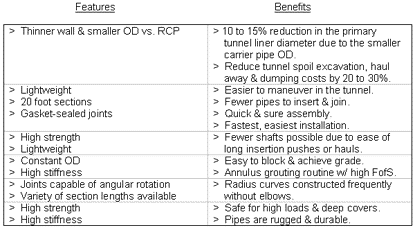2-Pass Tunnel Installations - Hobas Carrier Pipes Provide the Most Benefits
Introduction
Although the majority of Hobas pipes are installed by common open cut construction, these smooth wall, high strength pipes have earned their superior reputation and notoriety primarily due to their success in trenchless applications such as 2-pass tunnels. Hobas carrier pipes in tunnels provide the most benefits to the installer and to the owner.
Characteristics
• Description -
Generically, Hobas pipes are a centrifugal-cast, fiberglass-reinforced, polymer mortar (CCFRPM) construction.
• Scope –
- Diameters: 12" to 102" currently available.
- Standard classes:
- Stiffness: Typically between 36 and 72 psi is appropriate, although other values are available and are sometimes needed depending on conditions and joint configuration.
- Pressure: Most applications are non-pressure, however, ratings for 50, 100, 150, 200 and 250 psi or in-between classes are available.
- Section lengths: 20 ft. is standard, but 10, 6.5 and 5 ft. sections are sometimes used in curves or when small pits are desired.
- Joints: Several gasket-sealed, bell-spigot configurations are suitable based on installation method and service pressure:
- Non-pressure: Flush joint is the easiest to insert and block, although the FWC coupling and the low profile bell-spigot joints have also been used successfully.
- Pressure: FWC coupling (frequently with overwrap).
- Fittings: Although not used frequently in tunnel construction, a wide variety of mitered and molded fittings are available including:
- Elbows
- Tee base manholes
- Tees
- Wyes
- Reducers
- Laterals
- Nozzles
- Flanges
- Bushings: PVC or stainless steel bushings (typically for 2" pipe connections) are available for grouting or other operations.
Applications
Majority of applications are sanitary sewer interceptors, however, the pipes are also ideal for other services including storm drainage, industrial effluents, culverts, potable water, sea water, sewer force mains and other corrosive environments.
Installation
• Carrier Pipe Insertion -
Carrier pipes may be placed in the tunnel one at a time or may be inserted in a continuous push. If the insertion method involves sliding, the Hobas carrier pipes should be protected from excessive abrasion. Normally, insert the carrier pipes spigot end first with the pushing force, if used, applied to the pipe wall end inside of the bell. Do not apply the pushing load to the end of the bell. Also, assure that the allowable safe pushing force is not exceeded (consult the Hobas product brochure or contact your Hobas representative to obtain this value).
• Joint Assembly -
All of the gasket-sealed joints feature push-together assembly. No chemicals or adhesives are needed. Only lubrication of the bell ID and spigot OD is required. Due to the smooth, constant OD pipe surface, on grade blocking contacting the pipe invert OD, automatically assures proper vertical alignment for joining.
• Blocking Schemes -
The carrier pipes are typically blocked within the tunnel to secure line and grade, and to aid in control of deformation of the carrier pipes during annulus grouting. Two typical blocking schemes are shown in the adjacent figures. The actual blocking scheme must be designed so the uplift contact pressure of the pipe wall against the blocks does not exceed allowable limits (maximum contact pressure approximately equal to the pipe stiffness).
• Grouting -
Generally the annular space between the carrier pipe OD and the tunnel ID is filled with grout to provide support to the carrier pipe to resist external loads. Minimum compressive strength of the grout shall be as required to assure the structural adequacy of the completed installation (typically not less than 100 psi @ 7 days). During grout placement, assure that both the safe grouting pressure of the carrier pipe (typically 18% of the pipe stiffness) is not exceeded and that the grout density, lift heights and blocking scheme are coordinated to control the carrier pipe deformation to within allowable limits. Contact Hobas for analysis assistance.
• Experience -
Over 100,000 ft. installed as a tunnel carrier in diameters 30" to 102" by the end of 1999.
Benefits
Hobas CCFRPM pipes provide many benefits to the user and installer. Some are applicable to any installation method and may be termed universal. Others are most significant and valuable specifically on trenchless installations such as carrier pipes in two-pass tunnel construction.


Conclusion
Specify and use Hobas centrifugal cast fiberglass-reinforced polymer mortar pipes on your next tunnel project to experience and enjoy these many, unique, cost saving benefits.
Hobas Pipe
1413 E. Richey Rd.
Houston, Texas 77073
United States
Phone: 281-821-2200
Fax: 281-821-7715
